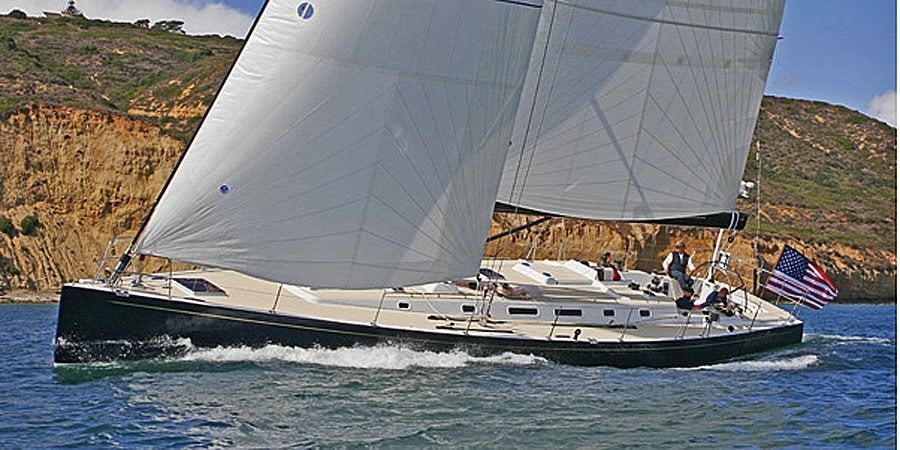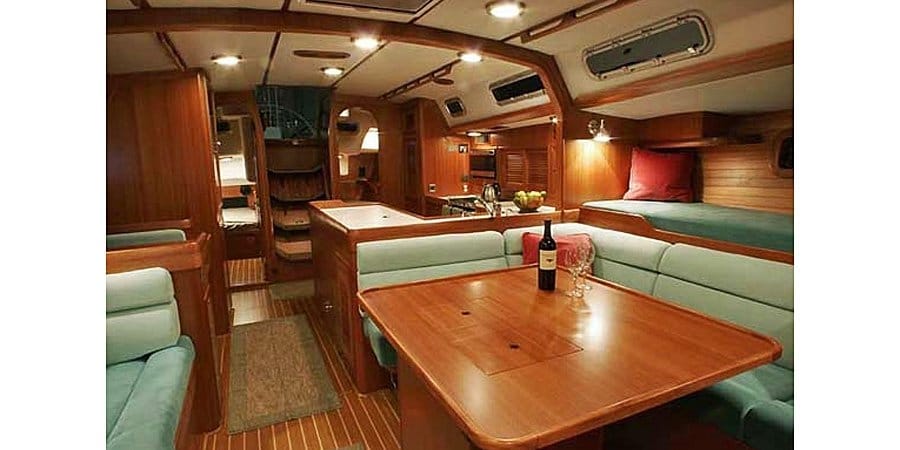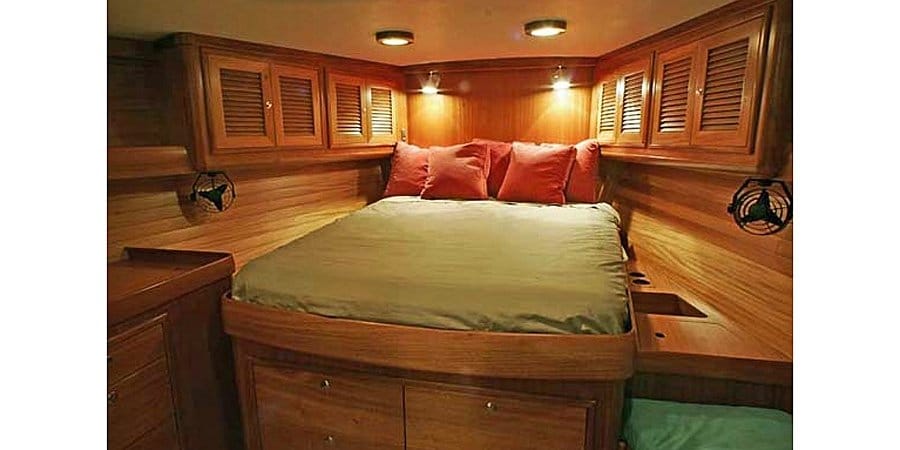
For a project that ultimately took on a life of its own, with ever-escalating tiers of expectations and complexities, it started off fairly simply. Southern California J/Boats dealer Jeff Brown had a pair of clients who, between them, had owned and sailed several Js, including the very same 53-foot J/160, the largest boat in the company’s line. They were both fans of the longstanding J/Boat concept, the beginning and end of which has always been seakindly, easily driven hull shapes with ample but manageable well-proportioned sail plans that are a joy to sail. But Brown knew that this particular set of owners had grander, if slightly different, aspirations, ones that would call for a sailboat that was bigger and tougher while also possessing more luxurious appointments and state-of-the-art systems than those offered by J/Boats in the company’s 53-footer.
So the question was straightforward: Given a blank sheet of paper, an endless wish list, and the desire to create the ultimate J/Boat for performance offshore cruising, what could be achieved?
“We always used to have these ‘What if?’ design conversations,” said Brown. “It wasn’t like there was anything wrong with the boats they’d had. But we just kept wondering, ‘What could be better?'”
With input from owners Jim Madden and Peter Johnson, Brown drafted a letter to J/Boats president Jeff Johnstone detailing the specifics of what they’d want in such a vessel. Among their points: circumnavigation-level strength and safety; J/Boat-like ability in steering and tracking, along with strong upwind and reaching potential and superior downwind performance; ease of handling by a doublehanded crew; traditional low-profile cabin lines; competitiveness in offshore races or rallies; a categorical step-up from the 160 in cruising comfort; and strong value retention, with the potential to serve as the company’s flagship.
It was music to Johnstone’s ears. “On a fairly regular basis, we’ll have discussions with owners who ask when J/Boats is going to come out with a bigger one,” he said. “So we’d actually worked through several designs from 63 to 70 feet, based on past discussions with key clients.”
Those previous talks, however, had never gone beyond the theoretical stage. But now Johnstone had a set of owners more than ready to turn the dream into reality. The first, Peter Johnson, was based in Kaneohe, Hawai’i. “He wasn’t really into racing,” said Johnstone, “but he wanted to sail off the coast of Hawai’i, which is known for big waves and lots of breeze, so he was looking for something large enough to be comfortable in those conditions but also with the luxury and accommodations down below to entertain friends.”
Jim Madden, the second owner, made his home in Southern California, and he had a broader racing background, particularly in south-of-the-border Mexican events. Johnstone said, “He was more in the vein of ‘Let’s race point-to-point and then cruise home.’ I think with a lot of our boats, even the dedicated cruising boats like the 42 and the 46, the owners have always enjoyed doing an Atlantic Rally for Cruisers or a ‘cruise race’ knowing that they have a boat that can perform well with a smaller crew or reduced sails. And once they reach their destination, they’re in their new cruising grounds. That’s always been a great niche for us.”
With the general parameters laid out, it was time to lock in the specific size.
“The overall purpose of the boat was performance cruising and passagemaking,” said Johnstone. “So we knew the boat had to be built robustly, to very strong scantlings. Then you take a look at what the layout’s going to be, roughly to size, and then it really gets into the details. You need to know what the boat’s going to weigh, and to do that, you need to know the number of cabins. From that standpoint, you almost have to reverse engineer it.
“It always comes back to this question: ‘What does the owner really want to accomplish, and why doesn’t the current boat do that?'” he added. “So you arrive at a size where you can accomplish those goals. There’s no sense building an 80-footer if you can do it in 60. In this case, I’d say both owners were initially thinking in the 62- to 65-foot range, and once we added all the bells and whistles they wanted, we determined that 65 feet would fit it all in.”
Still, Johnson’s boat-hull number one, Maitri-and Madden’s-hull number two, Brand New Day-turned out to be quite different craft in several aspects, which the company was able to easily address since the J/65 is very much a semicustom, “series production” (as opposed to a one-off) design. Maitri, for example, is fitted with the standard 9-foot keel, has a mahogany interior, and is fully systemized right down to a bow thruster for tight docking maneuvers and a charging system specified to meet the vagaries and demands of round-the-world voyaging. Brand New Day, on the other hand, is optimized for distance racing with a deeper, 10-foot-6-inch keel; pared-down systems; and lighter-weight accommodations in the ends of the boat; she features cherry furniture and joinerwork in her interior.
Like all current J/Boats constructed in the United States, the J/65 was designed by the father-and-son team of Rod and Al Johnstone and was built in Rhode Island at Pearson Composites. Jeff Johnstone notes that boats like the J/160 are already highly customized to their owners’ wishes, but the 65 took the notion to fresh heights for J/Boats. To do so, the company assembled a dedicated team: Pearson engineer Clive Dent; project manager David Lake, whose background is in high-end Grand Prix programs; and Ben Hall and PJ Schaffer of Hall Spars, who were responsible for the boat’s beautiful three-spreader, carbon-fiber rig.
“I’ve represented the J/Boats line, and they’re great boats,” said Brown, who served as the owners’ representative for both 65s. “But with this project, in terms of yacht-quality fit and finish, the bar was raised and set at a new level. That was probably the single biggest challenge: taking that whole other step.”
For U.S. East Coast sailors like myself, the J/65 was more rumor than reality for quite some time. After their respective launches in mid-June 2005 and January 2006, both boats were immediately whisked off to Southern California for commissioning, after which Maitri was sailed directly to Hawai’i and Brand New Day set sail in the Puerto Vallarta Race. Last year, however, Madden decided to ratchet up his racing program in major fashion and commissioned a new 66-foot Grand Prix raceboat. Brand New Day returned east to her home waters of Rhode Island’s Narragansett Bay, where at press time she was for sale. So while I certainly knew about the boats, I’d never laid eyes on one except in photos until last fall.
It turned out to be worth the wait.
In the interests of full disclosure, it should be noted that I’ve owned a couple of J/Boats in my day-a J/24 and a J/30-and feel the company has earned its respected stake in the marketplace by producing consistently good boats that have remained true to a highly refined design philosophy. If you like to go sailing-and I’m talking about the pure, unadorned act of hoisting a sail and catching some breeze-it’s hard not to enjoy a J. And on one hand, I do have to agree with Jeff Brown, for the J/65 is a significant achievement for the builder, a remarkable, beautifully engineered and constructed sailing machine. But on the other hand, it’s just another J/Boat, and I mean that in the best possible way.
First off, to my eye, the boat looks terrific. I’m on record as being an enthusiast-for many reasons-of the new era of deck-saloon cruisers, but there’s also something exactly right and aesthetically pleasing about the 65’s long, low, purposeful profile, which is complemented by the generous rig and, in particular, the large, roachy mainsail. This is a boat that appears fast and raring to go on paper, never mind on the water.
The hull and deck were built utilizing TPI’s patented resin-infused SCRIMP composite-sandwich method of construction, using unidirectional carbon-fiber with biaxial E-glass and vinylester in the skins, Baltek end-grained balsa core in the hull, and Core-Cell foam core in the deck. The boat comes with a transferable 10-year warranty against hull blisters. Brand New Day sports expansive beige decks and striking, impeccable Flag Blue topsides, with fitting and fairing from the Allpaint yard in nearby Bristol, Rhode Island.


By all measures, it’s a handsome yacht. The interior is inviting and impressive, with a massive owner’s stateroom forward, the focal point of which is the centerline queen-size berth, with four good-size storage lockers beneath. The head and shower stall are adjacent and can also be accessed through the forward “passage cabin” just abaft the stateroom, which contains an elevated single berth to starboard and more storage areas below it. A pair of guest staterooms aft, each with a large double berth that will also serve as excellent quarters under way, round out the sleeping arrangements. A second head and shower unit are also well aft, to port.
The saloon is centered around the varnished dining table and U-shaped wraparound settee to port (with an excellent sea berth outboard and above it); opposite is another comfortable settee, the entertainment center, and more storage cabinets, which is an ongoing theme throughout the boat. The forward-facing navigation station is to starboard, the galley to port. The latter is yet another spacious affair, with centerline fridge and freezer (weight placement, and its ramifications regarding sailing performance, clearly came into play at every juncture of the design process), and all the other accoutrements one would expect (and a few you might not, like the 25-bottle wine-storage unit). The layout keeps the cook squarely in the midst of the action.
Handily placed just aft of the nav area is the Mastervolt AC/DC panel-the centerpiece of a fully integrated Mastervolt electrical system designed by a New Zealand company, Top Logic. The system includes a generator, inverter, battery chargers, transformer, and battery-control system, among many other components. The auxiliary is a 125-horsepower Yanmar with hydraulic drive. All of the boat’s gear, from the Icom radios to the Ockam sailing instruments to the Lewmar winches to the Harken hardware to the Reckmann hydraulic headsail-furling unit, is absolutely top shelf. It’s safe to say that on the J/65, no reasonable expense was spared, no stone left unturned.
All that’s well and good, of course, but the J/65’s true reason for being is superior performance under sail, and I was itching to get my hands on the boat’s feathery 72-inch carbon wheel. I got my wish last fall on an ideal day for sailing, with a steady 12-knot northerly gusting into the mid-teens under bright sunshine on Narragansett Bay. After hoisting the mainsail with the electric halyard winch, we unrolled the 100-percent jib, headed hard on the breeze, and the boat suddenly came alive.
Like every J/Boat, the main thrust of the sail plan is generated by the mainsail; the fore-triangle dimensions are such that the main is complemented by the nonoverlapping headsail, which makes it simple to tack and control. Upwind, we notched 8-plus knots in truly effortless style. Helming was easy, as was the motion, as the boat clipped through the moderate chop as if on rails.
Tacking was a breeze, as the relatively small jib flipped over quickly and was winched home with the push of a button on the electric primary. All sail controls are within reach of the driver-another trait common to the J/Boat line-and on the J/65 they’re augmented by a full Navtec hydraulic package for the backstay, vang, outhaul, and even the traveler, which is also raised or eased by the twist of a knob. I’ve sailed more than a few sailboats in the 65-foot range before, but none that were set up so well for dedicated shorthanded operation.
When I was perched to windward and sighting forward, there seemed to be a whole lot of boat in front of me, but visibility of both the water and the telltales was excellent. As the wind built, so did our SOG, topping off at between 8.5 and 9.2 knots closehauled. The boat was as quiet as could be. We cracked off slightly and instantly leaped over 10 knots, which one would expect to see on a regular basis offshore in any sort of breeze. The helm was instantly responsive to the slightest adjustments and couldn’t have been any lighter. As advertised, the J/65 was a delight under sail.
When you think of J/Boats, you don’t necessarily think “cruising,” but perhaps that’s an oversight. There have been 35 J/160s built, 65 J/44s, and another 45 J/46s, all which shared the same, modified mold. Throw in 40 J/40s and 40 more J/42s-which, again, came from the same mold-as well as the production runs for the J/37 and J/37c, and suddenly you’re talking about several hundred offshore cruising boats.
“About 45 percent of our new-boat buyers had a J/Boat before,” said Johnstone. “Another 20 percent had sailed a J as a crewmember. So about 65 to 70 percent of the boats we sell go to people who’ve had experience with the boats.”
Clearly, it’s a brand that promotes loyalty. Johnstone hopes some of those previous owners will make the move to a J/65. “This was a lot of fun to work on,” he said. “We’d love to build some more. And frankly, if we had a couple of J/Boat owners who started talking about a 75-foot cruising boat, our ears would perk up, though I don’t think anyone really needs anything bigger than 65 feet for cruising.”
In fact, Johnstone says the company is thinking hard about new cruising concepts in the 32- to 52-foot range. It’ll be interesting to see what they come up with. But that’s somewhere down the highway. For now, with the J/65, the company has an exceedingly fine flagship for the foreseeable future.








